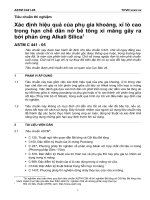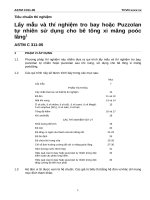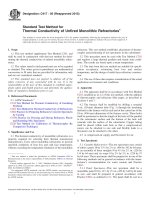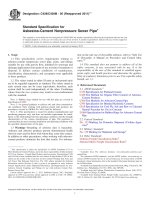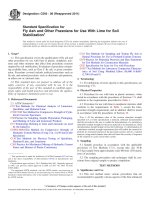Astm c 1413 05 (2011)
Bạn đang xem bản rút gọn của tài liệu. Xem và tải ngay bản đầy đủ của tài liệu tại đây (97.66 KB, 4 trang )
Designation: C1413 − 05 (Reapproved 2011)
Standard Test Method for
Isotopic Analysis of Hydrolyzed Uranium Hexafluoride and
Uranyl Nitrate Solutions by Thermal Ionization Mass
Spectrometry1
This standard is issued under the fixed designation C1413; the number immediately following the designation indicates the year of
original adoption or, in the case of revision, the year of last revision. A number in parentheses indicates the year of last reapproval. A
superscript epsilon (´) indicates an editorial change since the last revision or reapproval.
1. Scope
C761 Test Methods for Chemical, Mass Spectrometric,
Spectrochemical, Nuclear, and Radiochemical Analysis of
Uranium Hexafluoride
C776 Specification for Sintered Uranium Dioxide Pellets
C787 Specification for Uranium Hexafluoride for Enrichment
C788 Specification for Nuclear-Grade Uranyl Nitrate Solution or Crystals
C996 Specification for Uranium Hexafluoride Enriched to
Less Than 5 % 235U
C1334 Specification for Uranium Oxides with a 235U Content of Less Than 5 % for Dissolution Prior to Conversion
to Nuclear-Grade Uranium Dioxide
C1346 Practice for Dissolution of UF6 from P-10 Tubes,
C1347 Practice for Preparation and Dissolution of Uranium
Materials for Analysis
C1348 Specification for Blended Uranium Oxides with 235U
Content of Less Than 5 % for Direct Hydrogen Reduction
to Nuclear Grade Uranium Dioxide
1.1 This method applies to the determination of isotopic
composition in hydrolyzed nuclear grade uranium hexafluoride. It covers isotopic abundance of 235U between 0.1 and
5.0 % mass fraction, abundance of 234U between 0.0055 and
0.05 % mass fraction, and abundance of 236U between 0.0003
and 0.5 % mass fraction. This test method may be applicable to
other isotopic abundance providing that corresponding standards are available.
1.2 This test method can apply to uranyl nitrate solutions.
This can be achieved either by transforming the uranyl nitrate
solution to a uranyl fluoride solution prior to the deposition on
the filaments or directly by depositing the uranyl nitrate
solution on the filaments. In the latter case, a calibration with
uranyl nitrate standards must be performed.
1.3 This test method can also apply to other nuclear grade
matrices (for example, uranium oxides) by providing a chemical transformation to uranyl fluoride or uranyl nitrate solution.
1.4 This standard does not purport to address all of the
safety concerns, if any, associated with its use. It is the
responsibility of the user of this standard to establish appropriate safety and health practices and determine the applicability of regulatory limitations prior to use.
3. Summary of Test Method
3.1 After dilution of uranyl fluoride or uranyl nitrate solution, approximatively 2 µg of uranium are deposited on a
rhenium filament. Analysis is performed in a thermal ionization
mass spectrometer (TIMS), uranium is vaporized and ionized
through electrons emitted by a second filament; ions are
extracted by an electric field, separated by a magnetic field, and
collected by four collectors on mass 234, 235, 236, 238. The
collectors are either faraday cups or electron multipliers
collectors (ion counting).
2. Referenced Documents
2.1 ASTM Standards:2
C696 Test Methods for Chemical, Mass Spectrometric, and
Spectrochemical Analysis of Nuclear-Grade Uranium Dioxide Powders and Pellets
C753 Specification for Nuclear-Grade, Sinterable Uranium
Dioxide Powder
3.2 Evaporation sequence and ion counting time are adjusted with the analysis of standard solutions of certified
isotopic content. Nitrate and fluoride solutions lead to two
different calibrations.
1
This test method is under the jurisdiction of ASTM Committee C26 on Nuclear
Fuel Cycle and is the direct responsibility of Subcommittee C26.05 on Methods of
Test.
Current edition approved June 1, 2011. Published June 2011. Originally
approved in 1999. Last previous edition approved in 2005 as C1413 – 05. DOI:
10.1520/C1413-05R11.
2
For referenced ASTM standards, visit the ASTM website, www.astm.org, or
contact ASTM Customer Service at For Annual Book of ASTM
Standards volume information, refer to the standard’s Document Summary page on
the ASTM website.
4. Significance and Use
4.1 Uranium hexafluoride used to produce nuclear fuel must
meet certain criteria for its isotopic composition as described in
Specifications C787 and C996.
Copyright © ASTM International, 100 Barr Harbor Drive, PO Box C700, West Conshohocken, PA 19428-2959. United States
1
C1413 − 05 (2011)
7.4 Isotopic Uranium Standards
7.4.1 UF6 of certified 236U, 235U isotopic composition,
such as COG 006, 008, 009, 010, 013, 014, 015.5
7.4.2 U3O8 of certified isotopic composition, such as NBL
CRM U-010, U-020, U-030, U-050, CEA 014.6
7.4.3 U3O8 from reprocessed origin and of certified 236U
composition, such as MIR 1.6
5. Interferences
5.1 This test method only applies to nuclear grade uranium
matrices (as defined in Specification C753, C776, C787, C788,
C1334, or C1348). Large amount of impurities, which are
found, for example, in uranium ore concentrates, may bias
results. A purification step may be necessary, as described in
Specification C696.
7.5 Hydrofluoric Acid (0.05 M)—Dilute 173 µL of HF
solution (sp gr 1.18, 28.9 M) to 100 mL with water.
5.2 The type of acid used (HF or HNO3) and its concentration will strongly influence the obtained isotopic results (see
9.2).
7.6 Nitric Acid (0.1 M)—Dilute 0.6 mL of concentrated
HNO3 (sp gr 1.42, 16 M) to 100 mL with water.
6. Apparatus
8. Preparation of Apparatus
6.1 Thermal Ionization Mass Spectrometer (TIMS)—
Configured with four detectors.3
6.1.1 This test method requires a mass spectrometer with a
resolution greater than 400 (full width at 1 % of peak height)
and an abundance sensitivity of less than 10–5 (contribution of
mass 238 on the mass 237). A typical instrument would have
230 mm radius of curvature, single or double focussing, and
single or multiple filament design. The pressure in the ionization chamber should be below 3 × 10–6 torr (typically 10–7
torr).
8.1 Prepare the thermal ionization mass spectrometer in
accordance with the manufacturer’s recommendations. A verification of collector yield and an optimisation of the ion beam
may be necessary on a daily basis. This can be achieved by
heating the ionizing filament, locating the 187Re peak and
focusing for maximum intensity. The 187Re signal is normally
above 0.1 to 0.2 × 10–11 A.
8.2 A verification of mass calibration is usually performed
on a weekly basis in order to optimize the value for the
magnetic field.
6.2 Preconditioning Unit for the TIMS—To dry filament
after deposition of uranyl solution.
9. Calibration and Standardization
6.3 Rhenium Filament Loading Assembly for the TIMS—In
this test method, a double filament set up is used.
9.1 Because of mass segregation during the evaporation of
uranium, it is necessary to adjust the ion acquisition time
program with the analysis of uranium standards. The number
of standards and the range covered will depend on the
instrument used, the evaporation sequence, and the accuracy
which is required.
9.1.1 For the analysis of 235U in the 0.1 to 5.0 mass % range
and of 234U in the 0.0055 to 0.05 mass % range, four to seven
standards should be used (see Table 1). For analysis of 236U in
the 0.0003 to 0.5 mass % range, only two standards were used.
6.4 Pipets—Automatic or equivalent, 1, 20, 50, and 100 µL.
6.5 Pipets Tips—In accordance with 6.4.
6.6 Liquid Dispenser—2.5 mL.
6.7 Disposable Polypropylene Vials.
7. Reagents and Materials
7.1 Purity of Materials—Reagent grade chemicals shall be
used in all tests. Unless otherwise indicated, it is intended that
all reagents conform to the specification of the Committee on
Analytical Reagents of the American Chemical Society where
such specifications are available.4 Other grades may be used
provided it is first ascertained that the reagent is of sufficiently
high priority to permit its use without lessening the accuracy of
the determination.
9.2 Preparation of the Standards—Separate calibrations are
required for uranyl fluoride solutions and uranyl nitrate solutions.
9.2.1 Uranyl Fluoride Calibration:
9.2.1.1 UF6 Standards—General principles for hydrolysis of
UF6 are described in Test Methods C761 and Practice C1346.
Hydrolysis should be done in pure water (no HNO3 added).
Final concentration is for example 266 g uranium per litre
(20 % mass U).
7.2 Purity of Water—Demineralized or distilled water is
found acceptable for this uranium isotopic analysis.
7.3 High Purity Rhenium Filaments (> 99.95 %), with
geometrical characteristics in accordance with the TIMS manufacturer’s recommendations (typically thickness is 0.04 mm
and width is 0.70 mm). Some equipment may accept tungsten
filaments.
NOTE 1—Other concentrations may be used (for example, 10 % mass
U), provided that volumes in 10.2 are adapted to deposit the same uranium
amount on the rhenium filament.
NOTE 2—2 µg of uranium are deposited on the filaments. In case of
other filament geometries (see 7.3), other uranium amounts may be more
adapted (up to 10 µg U).
9.2.1.2 In a polypropylene vial, pour 2.5 mL of water and
add 20 µL of solution prepared in 9.2.1.1. Mix the vial content
by inverting vigorously to obtain a solution containing approximately 2 g/L uranium.
3
A reduced number of detectors may be used which will correspond to a reduced
number of isotopes analyzed. For single collector instruments, refer to Specification
C696.
4
Reagent Chemicals, American Chemical Society Specifications, American
Chemical Society, Washington, DC. For suggestions on the testing of reagents not
listed by the American Chemical Society, see Analar Standards for Laboratory
Chemicals, BDH Ltd., Poole, Dorset, U.K., and the United States Pharmacopeia
and National Formulary, U.S. Pharmacopeial Convention, Inc. (USPC), Rockville,
MD.
5
6
2
COGEMA/Service Laboratoire, BP 16, 26701 Pierrelatte Cedex, France.
CEA/CETAMA, BP 171, 30 207 Bagnols sur Cèze, France.
C1413 − 05 (2011)
9.3.2 The 235U/238U mass discrimination factor, B, is calculated as follows:
TABLE 1 Mass Ratios to Total Uranium
235
Reference
COG 006
COG 008
NBL CRM U–010
COG 009
COG 010
NBL U–020
COG 013
NBL U–030
COG 014
CEA 014
COG 015
NBL U–050
Reference
NBL CRM U–010
COG 006
COG 008
COG 010
COG 009
NBL U–020
COG 013
NBL U–050
CEA 014
COG 014
COG 015
Reference
COG 014
CEA 014
NBL U–020
NBL CRM U–010
NBL U–050
MIR 1
A
U/U (mass fraction, %)
Summary Statistics of Measured
Values
x¯
s
n
x¯ ± sx¯
0.7112 ± 0.0002
0.7110
0.0004
5
0.8676 ± 0.0008
0.8670
0.0004
20
0.9911 ± 0.0005
0.9918
0.0009
50
1.0705 ± 0.0010
1.0696
0.0005
5
1.3006 ± 0.0012
1.2995
0.0004
10
2.0130 ± 0.001
2.0131
0.0009
18
2.5959 ± 0.0026
2.5969
0.0005
10
3.0032 ± 0.0008
3.0042
0.0014
26
3.3678 ± 0.0034
3.3663
0.0006
20
3.3678 ± 0.0034
3.3699
0.0010
84
4.2960 ± 0.0042
4.2940
0.0011
10
4.9490 ± 0.0025
4.9449
0.0025
10
234
U/U (mass fraction, %)
Summary Statistics of Measured
Certified ValuesA
Values
x¯ ± sx¯
x¯
s
n
0.0053 ± 0.00002
0.0054
0.0001
50
0.0054 ± 0.0001
0.0052
0.0001
5
0.0069 ± 0.0001
0.0067
0.0001
20
0.0070 ± 0.0001
0.0069
0.0001
10
0.0088 ± 0.0001
0.0087
0.0001
5
0.0123 ± 0.00005
0.0123
0.0001
18
0.0224 ± 0.0002
0.0223
0.0001
10
0.0275 ± 0.00005
0.0273
0.0001
9
0.0288 ± 0.0006
0.0290
0.0001
84
0.0325 ± 0.0003
0.0327
0.0002
20
0.0378 ± 0.0004
0.0382
0.0001
10
236
U/U (mass fraction in %)
Summary Statistics of Measured
Certified ValuesA
Values
x¯
s
n
x¯ ± sx¯
0.0006 ± 0.0001
0.0010
0.0001
20
0.0051 ± 0.0001
0.0052
0.0001
84
0.0164 ± 0.00005
0.0164
0.0001
18
0.00675 ± 0.00003
0.0070
0.0001
50
0.0476 ± 0.0002
0.0475
0.0001
9
0.4002 ± 0.0006
0.4006
0.0001
30
Certified ValuesA
B 5 ~ 1/DM !
where:
B
=
DM =
=
Rs
R¯
=
@ ~ R¯ /R ! 2 1 #
s
(1)
mass discrimination factor,
mass difference = (238-235) = 3,
certified value of 235U/238U of standard, and
average measured value of 235U/238U for n different
analyses.
9.3.2.1 B should be below 2 × 10–4.
9.4 For each batch of routine samples to be analyzed, a
verification of the calibration of the acquisition program is
recommended. This is done by inserting in the batch a standard
with isotopic composition close to that of the samples.
10. Procedure
10.1 Prepare the solution to be analyzed in accordance with
9.2 to obtain either a fluoride or nitrate solution with an
uranium concentration of approximately 2 g/L.
10.2 Load 1 µL of solution 10.1 on the filament. Dry and
bake the filament with the TIMS preconditioning unit. The
heating sequence (electrical current, time applied) must be
performed in accordance with the manufacturer’s recommendation or user’s experience.
NOTE 3—For uranyl fluoride solutions, temperatures significantly
greater than 600°C must be avoided. The temperature of the filament
during the final stages of sample mounting is a critical parameter and can
produce a significant bias between runs if not carefully controlled.
10.3 Insert the filaments assembly into the mass spectrometer and obtain a pressure of less than 3 × 10–6 torr.
Certified values are given with the interval confidence of 1 sigma.
10.4 Analysis in accordance with the user’s standard operating procedure for TIMS analysis.
9.2.1.3 Other Standards—Uranium standard solutions, if
not from hydrolyzed UF6 origin, must be transformed to a pure
uranyl fluoride solution prior to the analysis. Dissolution of the
uranic material can be performed in accordance with Practice
C1347. The solution is then transferred in a platinum crucible
to be carefully dried on a heated plate to be transformed to
UO3. The residue is then dissolved with diluted HF (0.05 M) to
obtain an uranyl fluoride solution with an uranium concentration of 2 g/L and a fluoride concentration 1 g/L.
9.2.2 Uranyl Nitrate Calibration:
9.2.2.1 U3O8 Standards—The standards are dissolved in
accordance with Practice C1347. The solutions are evaporated
to dryness and the residue is transformed by calcination to
U3O8. It is then dissolved in 0.1 M HNO3 to give a solution
containing 2 g/L uranium.
9.2.2.2 Hydrolyzed UF6 Standards—Uranyl fluoride solutions with an uranium concentration of 2 g/L are evaporated to
dryness and dissolved in 0.1 M HNO3 to give an uranyl nitrate
solution containing 2 g/L uranium.
NOTE 4—The heating pattern for the filaments and the mass spectrometer ratio measurements may slightly vary depending on the instrument.
10.4.1 Heat the ionization filament to 5 A.
10.4.2 Heat the evaporation filament to 1 A.
10.4.3
Heat the ionization filament until a signal of 0.08 ×
–11
10 A is obtained, locate the 187Re peak and adjust the focus
for maximum intensity. Heat the ionization filament until a
signal of 0.2 × 10–11 A is obtained on the 187Re peak.
10.4.4 Heat the evaporation filament until a signal of 10–11
A is obtained on the 238U peak, focus for maximum intensity.
Heat the evaporation filament until a signal of 7 × 10–11 A is
obtained.
10.4.5 Start the ratio measurement (this should correspond
to approximately 30 minutes after step 10.4.1).
10.4.5.1 Determine the baseline at mass 233.5.
10.4.5.2 During a 32–second scan, acquire the 234U, 235U,
236
U, 238U signal on the four collectors. Calculate the ratio
234
U/238U, 235U/238U, 236U/238U, corrected from baseline.
10.4.5.3 Repeat step 10.4.5.2 ten times. Calculate the average ratio together with the estimated standard deviation.
Perform a Dixon test to eliminate anomalous points.
9.3 Analysis of the uranyl fluoride or uranyl nitrate standard
solutions is performed in accordance with 10.2-10.4.
9.3.1 Calibrate the TIMS in accordance with the manufacturer’s recommendations to achieve the user’s performance and
quality assurance criteria.
3
C1413 − 05 (2011)
10.4.5.4 Repeat steps 10.4.5.1-10.4.5.3 so that the total
acquisition time corresponds to that obtained during the
calibration (see 9.1).
where:
= atom percent of isotope i,
Ai
= mass percent of isotope i,
Wi
Ri, 238 = isotopic ratio of isotope i to 238 obtained in 11.2,
and
= nuclidic mass of isotope i.
Mi
11. Calculation
11.1 Calculate the average isotope ratio obtained from
section 10.4.5.4.
12. Precision and Bias
11.2 The final isotopic ratio may be corrected from mass
discrimination as follows:
R' 5 @ R/ ~ 11DM B ! #
where:
R'
=
R
=
DM =
B
=
12.1 Isotopic uranium standards have been analysed over a
four year period in three laboratories. Results, obtained for
235
U, 234U, 236U mass ratios to total uranium, are listed in
Table 1. For each standard, the average measured value, x¯, is
given together with the estimated standard deviation, s, obtained for n experiments. COG standards were analysed with
the fluoride calibration. NBL and MIR standards were analysed
with the nitrate calibration.
(2)
final isotopic ratio,
average raw ratio,
mass difference, and
mass discrimination factor, obtained in 9.3.
12.2 Precision—The estimated standard deviation, s, for
U is between 0.0004 and 0.0011 %, depending on the 235U
level. The estimated standard deviation for 234U and 236U are
usually below 0.0002 %.
235
11.2.1 This correction is not always necessary, depending
on B.
11.3 Calculate the atom and mass percent for all the isotopes
as follows:
R i, 238 3 100
Ai 5
236
11
(
j5234
Wi 5
238
(
(3)
R j, 238
A i M i 3 100
j5134
12.3 Bias—235U and 234U, all average measured values are
within the certified interval, which depend on the isotope level.
For 236U, a slight bias (0.0004 %) is found for low 236U
concentration.
13. Keywords
(4)
13.1 isotopes; thermal ionization mass spectrometry; uranium hexafluoride; uranyl nitrate solutions
Aj Mj
ASTM International takes no position respecting the validity of any patent rights asserted in connection with any item mentioned
in this standard. Users of this standard are expressly advised that determination of the validity of any such patent rights, and the risk
of infringement of such rights, are entirely their own responsibility.
This standard is subject to revision at any time by the responsible technical committee and must be reviewed every five years and
if not revised, either reapproved or withdrawn. Your comments are invited either for revision of this standard or for additional standards
and should be addressed to ASTM International Headquarters. Your comments will receive careful consideration at a meeting of the
responsible technical committee, which you may attend. If you feel that your comments have not received a fair hearing you should
make your views known to the ASTM Committee on Standards, at the address shown below.
This standard is copyrighted by ASTM International, 100 Barr Harbor Drive, PO Box C700, West Conshohocken, PA 19428-2959,
United States. Individual reprints (single or multiple copies) of this standard may be obtained by contacting ASTM at the above
address or at 610-832-9585 (phone), 610-832-9555 (fax), or (e-mail); or through the ASTM website
(www.astm.org). Permission rights to photocopy the standard may also be secured from the ASTM website (www.astm.org/
COPYRIGHT/).
4
